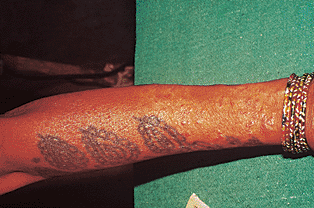Related article: Transmission of bacteria and onset of chronic disease

Tattoos
People are exposed daily to the intracellular microbiota that cause chronic inflammatory diseases. They exist in food, water, injectable medications, body fluids and have even been cultured from dry soil.
As with all injected substances, there is a small risk of introducing these pathogens during the process of tattooing.

Researchers have documented that diseases such as lupus vulgaris (painful skin lesions caused by M. tuberculosis bacteria) can be induced by a tattoo procedure.1) Tuberculosis, of course, is unquestionably a bacterial illness.
But the literature also contains multiple reports of sarcoidosis patients – a disease of supposedly unknown origin – also developing skin lesions within tattoos. According to one researcher, this is “a well-recognized occurrence in patients with sarcoidosis.”2) Ali reviews dozens of cases in which granuloma have formed, more often than not, years after the application of a tattoo.3) More than one case report describes how a patient developed sarcoidal granulomas in only one pigment of a tattoo4) – which suggests that the needle corresponding to that pigment was infected.
There are a number of explanations for how a tattoo could cause this reaction, but the most logical one is that tattoo needles introduce new pathogens into the skin. For one, the fact that sarcoid granuloma appear years after the application of a tattoo corresponds nicely with the length of time it takes for bacteria to grow.
[PMID: 12941097] [DOI: 10.1046/j.1468-3083.2003.00787.x]
[PMID: 16027303] [DOI: 10.1001/archderm.141.7.869]
[PMID: 18258148] [DOI: 10.2310/7750.2007.00040]

